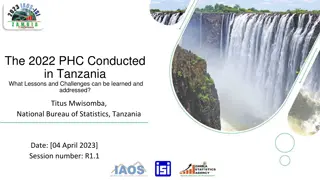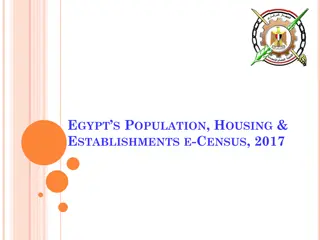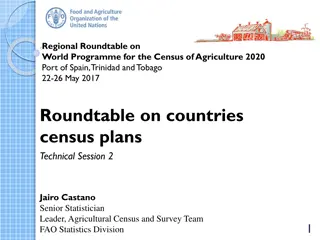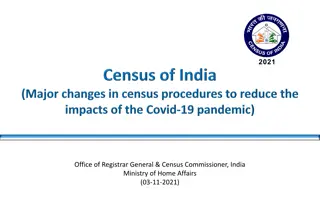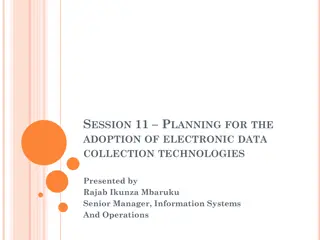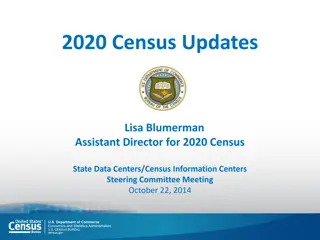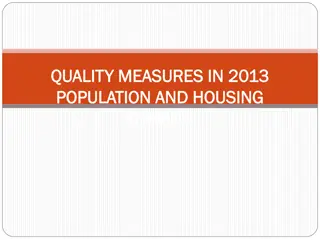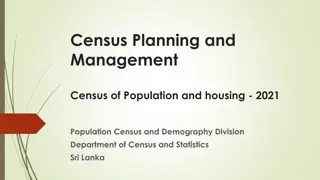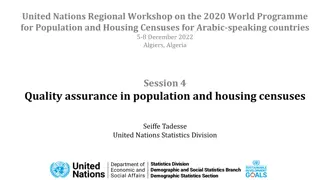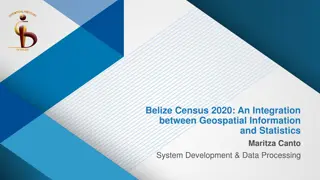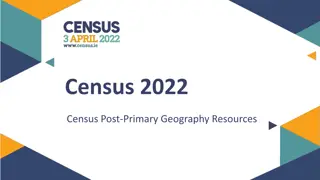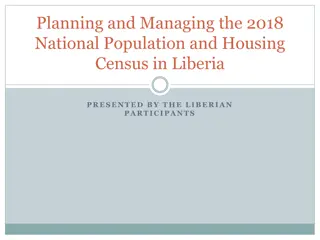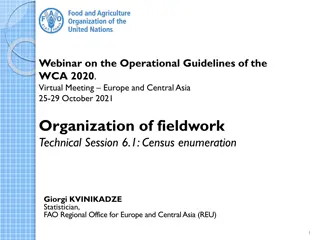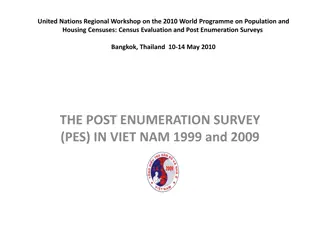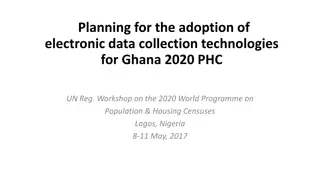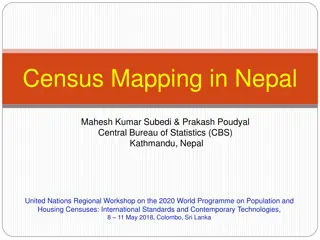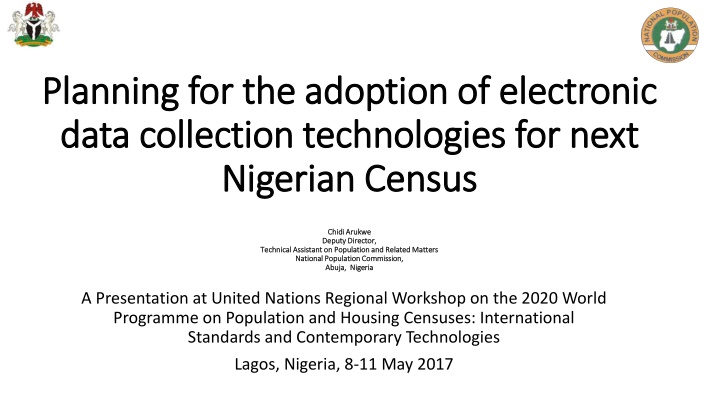
Electronic Data Collection Technologies for Nigerian Census Planning
The Deputy Director presents a plan for adopting electronic data collection technologies for the upcoming Nigerian Census, highlighting past census challenges, PDA justification, envisaged advantages, and key components of the proposed plan.
Download Presentation

Please find below an Image/Link to download the presentation.
The content on the website is provided AS IS for your information and personal use only. It may not be sold, licensed, or shared on other websites without obtaining consent from the author. If you encounter any issues during the download, it is possible that the publisher has removed the file from their server.
You are allowed to download the files provided on this website for personal or commercial use, subject to the condition that they are used lawfully. All files are the property of their respective owners.
The content on the website is provided AS IS for your information and personal use only. It may not be sold, licensed, or shared on other websites without obtaining consent from the author.
E N D
Presentation Transcript
Planning for the adoption of electronic Planning for the adoption of electronic data collection data collection technologies for next technologies for next Nigerian Census Nigerian Census Chidi Arukwe Chidi Arukwe Deputy Director, Deputy Director, Technical Assistant on Population and Related Matters Technical Assistant on Population and Related Matters National Population Commission, National Population Commission, Abuja, Nigeria Abuja, Nigeria A Presentation at United Nations Regional Workshop on the 2020 World Programme on Population and Housing Censuses: International Standards and Contemporary Technologies Lagos, Nigeria, 8-11 May 2017
Outline Introduction Past Censuses in Nigeria Census Challenges in Nigeria Phases of 2016 Census Pre-Census Activities Major elements of Next census in Nigeria Justification for use of PDA Envisaged Advantages Challenges Conclusion
Introduction The National Population Commission as the agency charged with the conduct of census is determined to implement a census plan that will guarantee high quality and reliable data with the use of modern technology. This presentation outlines some considerations for adoption of electronic data collection technologies and major components of the proposed plan for the next census in Nigeria.
Censuses in Nigeria Year Population 1952/53 30.42 1963 55.66 1973 79.76 1991 88.99 2006 140.431 200?
Census Challenges in Nigeria Poor culture of census taking Perception of census data for only political representation and revenue allocation Undue interference by political and community leaders in census plan implementation
Census Challenges in Nigeria contd. Mutual suspicion of inflation of Census figures by various administrative and geographical units Alleged deliberate and organized plan of over- enumeration in various administrative and geographic units Inadequate funding of post census activities Absence of suitable legal framework for early planning and periodic census Poor census product utilization
National context - Vision, Mission Census Project Goals Vision: To conduct a transparent, verifiable and accurate Census that will satisfactorily meet data users needs and facilitate national development Mission Statement: To use a modern technology that will involve direct data capture, GIS, satellite imagery and biometrics that will help to achieve the vision of the Census Project Project Goal: The goal of the census is to provide accurate, reliable and timely data for development planning, policy formulation and service delivery to improve the quality of live of the citizenry. Specific Objectives The Population and Housing Census has the following specific objectives To strengthen the capacity of the Commission to conduct the 2016 Population and Housing Census and Post Enumeration Survey (PES) using cutting edge technology. To increase the availability of accurate, reliable and up-to-date data on socio-economic and demographics of the country
Phases of Census Pre-census Census Enumeration Post Census Activities
Pre-census Activities Evaluation of 2006 Census for lessons Establishing strong foundation for census planning Technical working Group Adoption of a methodology Use of PDAs including capturing of minimal biometrics Preparation of Census Strategy and Implementation Plan and extensive consultations with some stakeholders
Pre-census Activities Contd Articulation of questionnaire items and technical review by national professionals, development partners and other select stakeholders Pilot EAD Methodology - Use of satellite imagery (1.5 mm) resolution to carry out complete demarcation of one LGA in Nigeria. Conduct Proof of Concept to assess the new methodology and ensure that the PDAs and ICT solutions will function seamlessly and meet census objectives
Business Case Analysis Business Problem Business Vision, Strategy or Objectives Business processes or technologies which are not operating efficiently Business Problem How to conduct reliable and acceptable census in Nigeria Available Options Option 1 - Traditional paper census Option 2 Use of Handheld devices technology Benefits, Goals and Measurement Criteria Feasibility Costs and Funding Plan Risks Associated with the adoption of this plan Issues Associated with the adoption of this plan Assumptions
Key planning/preparation considerations for adoption of electronic data collection technologies Oversight and management of technology investments Learn from other countries experience Institutional capacity development Comprehensive upskill program IT acquisition management OEMs specs Outsourcing IT systems development Data collection instrument Data transfer from the field Security Use of geospatial technology/digital mapping Testing at various stages Quality assurance and Improvement Risk Management Strategy
Experience of use of Handheld Device for data collection 2014 Verbal and Social Autopsy Survey 2014 Health and Life Experience of Young People Survey (HALIS) 2015 Nigeria Education Data Survey 2015 Malaria Indicator Survey 2016-17 Enumeration Area Demarcation - collection of attribute data
Risk Management Framework Quantifying the probability of each risk Context definition Costing the risk mitigation strategies of each risk Risk identification Identify the risk mitigation strategies for each risk Risk assessment Probability of each identified risk Quantifying the impact of consequences of each risk
Key determinants for adoption of use of hand-held electronic devices Institutional Technological Economic Human social and cultural factors Other issues Redesigning of census processes Maximising the benefits of investment in new data collection technology Long term benefit
Redesigned census processes and benefits of investment in new data collection technology Decision to use electronic data collection technologies and geospatial technologies have largely impacted considerations for planning, designing and implementing census operations. Almost paperless data collection regime Redesigning of training content and plan Inclusion of Electoral Districts/wards into geospatial database Long term production of sustainable GIS infrastructure that will generate revenue Provide easier and cheaper mechanisms for continuous updating of EAs after census Field operations plan and management Data processing
Justification for use of PDA Implementation of a complete GIS-based EAD and IT- driven Census enumeration will guarantee complete coverage and enumeration of all persons, households, buildings, EAs, Localities/towns/cities/ in such a manner that can be verifiable promptly by all stakeholders. This approach will provide Census managers the desired leverage to manage the census project successfully by promptly responding to issues or queries from any place before, during and after the Census
Major elements of the next Census Adoption of a fully digitized enumeration area demarcation methodology on a GIS platform using very high resolution (range 05.mm 1.5mm satellite imagery for the development of a new seamless National Frame; Census should be electronic (use of PDAs) Minimum biometric parameters to be captured during the census should include 2 fingerprints and facial impressions, Generation of Population Census Unique Identity Number (PCUIN) for verification
Methodology for next Population and Housing Census The methodology for next Census will be de facto based; Interviewers will collect information from members of the household/persons physically present at the time of enumeration in a building and within an Enumeration Area, using the Electronic Data Capture device containing census instruments. Thereafter, the left middle finger, thumb prints and facial impression of all respondents will be captured.
Major elements of the next Census Contd Building numbering, household listing and housing census should be conducted separately from the population census; A modern Data Centre will be established at the headquarters A robust de-duplication technology should be deployed to ensure verification and generation of unique identity numbers
Major elements of the next Census Contd The Data Processing Centres should be equipped to serve as backup / buffer data centres and to process migration and vital registration data after the census A robust network infrastructure and internet band will be provided to support data transmission and unified communication Dissemination of Census data will be largely electronic using the geo portal website, smart phones, social media etc.
Enumeration Procedure. The building numbering, household listing and housing census will be conducted before the actual population enumeration as follows: Each enumeration team will be assigned a map of a defined area to cover (EA Map) from the national EA frame. Use a copy of the Building numbering/household listing information according to locality/towns in clearly defined boundaries for the area. Identify the buildings on the ground and update using building/ household listing form where necessary because of time lag between the delineation and actual census exercise. Using the Electronic Data Capture device, obtain information as contained in the electronic census instrument on bio data(socio- economic, demographics) housing characteristics and biometrics from each member of the household physically present in the building. The biometric parameters of the respondents will be captured; Left middle finger and thumb prints, and Facial impression
Envisaged Advantages Immediate Quality control at the point of data entry Control of data filling by automatic skips in the form Direct transmissions of collected data to central systems Dispensing the transportation of high volumes of paper questionnaires and their handling in data collection centers Accurate location of all buildings units visited especially in rural areas(capturing of the coordinates Lat-long) No enumerator s codification in the field or looking up codes from external source for states, LGAs etc. during the census Transformation of data collection regime in Nigeria. Continuous use of devices for Vital Registration Exercise, etc.
Envisaged challenges contd. inadequate funding and timely release of funds Inadequate manpower to handle GIS and Data capture devices effectively. Huge gap between actual demand and supply of imagery for EAD. Inadequate public power in all locations to keep devices charged and data centers up 24/7 Poor network infrastructure in the country to ensure uninterrupted transmission of data from all locations, low quality connections, network congestion
Envisaged Challenges Contd Equipment failure Loss of equipment Insufficient technical support bases Data Security Inadequate in-house skillset to develop both hardware and software( web based for streaming) Lack of skills /funds to build and maintain data centers
Un-envisaged challenge Economic Recession Planning and conducting PHC during recession
Conclusion Census taking has been a major task due to a number of technical and non-technical factors. The greatest challenge in Nigeria is to conduct a census that will be auditable, verifiable and produce credible and reliable results for all the stakeholders. Only an IT-driven census will meet all these criteria in Nigeria using handheld device technology. We hope we shall overcome the Envisaged Challenges and have a successful census.

